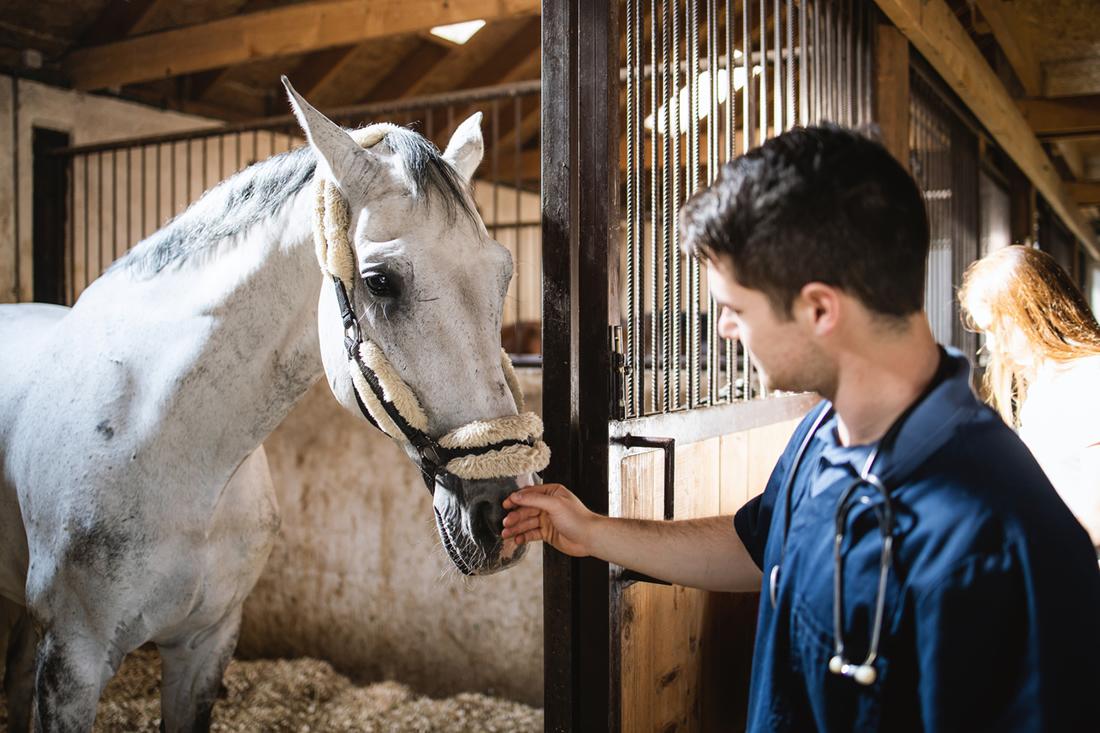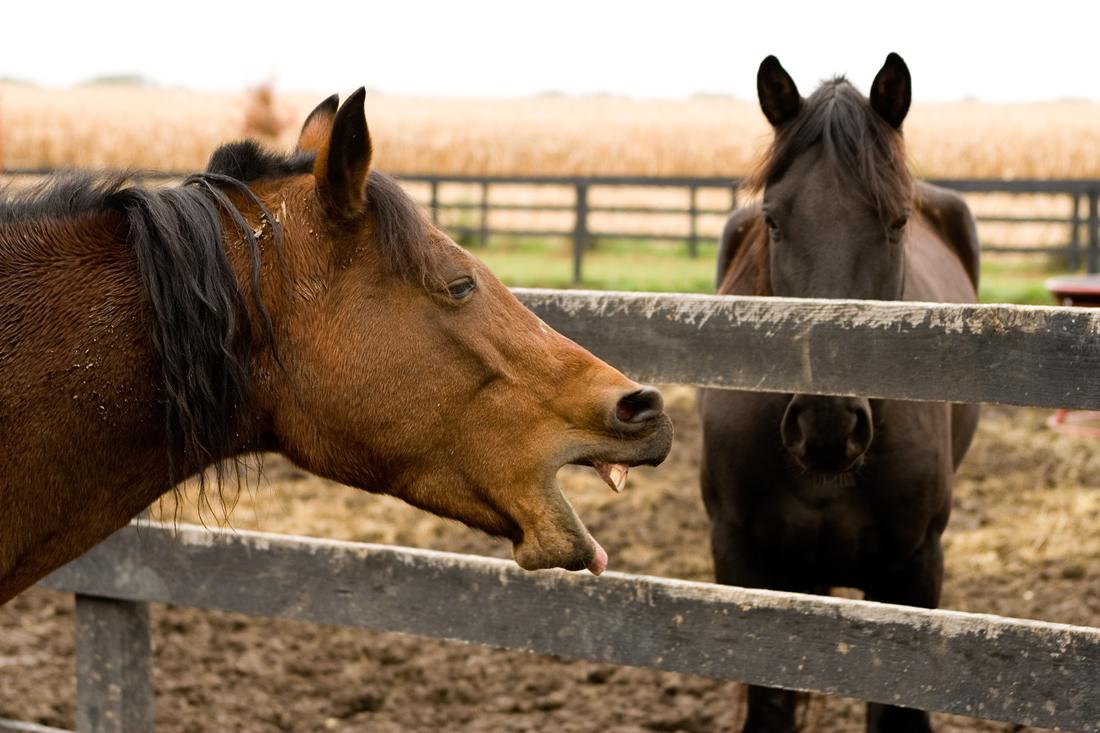Strangles, also known as equine distemper, is a highly contagious disease caused by the bacteria Streptococcus equi.
Young horses are most susceptible to developing strangles disease. This condition most commonly occurs in horses under the age of two. [1]
The name “strangles” comes from the common sign of dysphagia or trouble swallowing that some horses experience, caused by enlarged lymph nodes.
If severe enough, horses can suffocate leading to death. However, the severity of the disease varies greatly and is dependent on the status of the horse’s immune system.
The first written record of strangles was in 1251, reported by an officer in the imperial court of Emperor Frederick II in Italy.
Despite modern improvements in the health and management of horses, strangles continues to be one of the most frequently diagnosed infectious diseases of horses worldwide. [2]
Symptoms of Strangles in Horses
Most horses display classic signs of strangles, but not every horse has the same symptoms.
Younger horses usually show more severe signs and typically develop lymph node abscesses on the head and neck.
Other common symptoms of strangles include fever and lethargy. Fever is often persistent and may exceed 42oC (107.6oF).
Horses can also develop inflammation of the pharynx, which can lead to a reluctance to eat or drink. They may stand with their necks extended and appear depressed. [2]
Nasal discharge, as well as discharge from the eyes, is also common. Some horses will develop a cough which may be associated with eating. Horses may expel discharge from the mouth or nose with coughing or eating as well. [3]
Lymph Node Abscesses
Lymph node abscesses usually rupture and drain into the guttural pouches (at the back of the jaw, behind the eye).
The guttural pouches then drain into the nasopharynx between 7-28 days after infection. This results in the profuse nasal discharge that strangles is well known for.
Once the abscesses drain, the infection is usually resolved. In fact, most horses with equine distemper recover over a period of weeks. [2]
Expulsion of large amounts of discharge from the mouth or nose with coughing, eating, or a lowered head position suggests a collection of pus (empyema) in the guttural pouch. [3]

Prognosis & Antibody Protection
Older horses can contract strangles as well, but are usually less severely affected than younger horses and recover more quickly.
Older horses, as well as weanlings with waning maternal antibody protection, can develop a mild form of the infection called catarrhal or atypical strangles. [3]
Horses affected by catarrhal strangles often display mild respiratory symptoms, but do not develop abscesses.
If the dam has recovered from strangles or has been recently vaccinated, young foals are often protected by ingesting immunoglobulins (antibodies) in the dam’s milk.
These antibody proteins coat the upper respiratory tract and mucous membranes of the mouth. [4] The foals will continue to be protected until weaned. [3]
Unfortunately, however, 20-25% of horses recovering from strangles can suffer a second attack of the disease within several months. [3]
How Strangles Spreads
Equine distemper can occur at any time throughout the year but tends to occur more in Spring. [5]
This infection is highly contagious and often affects multiple horses on the same farm. Fatality rates can be as high as 8 or 9% in large farm outbreaks. [3]
Nasal shedding of S. equi bacteria usually begins 2-3 days after onset of fever and often persists for 2-3 weeks. Some horses can shed the bacteria for much longer if infection persists in the guttural pouch or sinus cavity. [3]
Transmission of infection can occur through direct or indirect contact of horses. Direct contact involves horse-to-horse contact with normal equine social behavior.
Indirect transmission occurs through contaminated housing, water sources, feed or feeding utensils, as well as tack and other equipment. The clothing of handlers and veterinarians can also transmit the disease. [3]
Asymptomatic Transmission
It’s important to note that even horses with mild cases of strangles can shed the bacteria and spread it to other animals.
Infected horses can become healthy but continue to harbour the S. equi bacteria for years. These horses intermittently shed bacteria into the environment and can trigger new outbreaks of the disease. [6]
In fact, researchers now believe that transmission of strangles from healthy animals may be of greater importance than that of sick horses. These horses are referred to as silent carriers and often have guttural pouch empyema (pus) or chondroids (hardened balls of pus), which may go unnoticed. [7]
Diagnosing Strangles
Strangles can be diagnosed through symptoms alone or your veterinarian may perform endoscopy of the upper airway to identify swelling in the pharynx.
Bloodwork may show varied results. However, an increase of peripheral blood neutrophils on a complete blood count or an increased level of fibrinogen in the blood can suggest a strangles infection. [3]
PCR tests can be used to test for presence S. equi at multiple points to see if the horse is still shedding the bacteria. This is done with a nasal swab. [8]
Treating Strangles
Treatment of equine distemper often depends on the stage and severity of the disease. Most cases require no treatment other than proper rest and soaked/softened food while the illness runs its course.
The animal should be kept isolated from other horses during the period of infection. Do not transport the horse to a new location.
It is recommended to maintain a quarantine facility at least 10 – 25 metres away from other horses and use separate water buckets, feed mangers, grooming, tack, and other equipment.
Antibiotics
Veterinarians disagree as to whether antibiotic treatment should be used. In many cases, antibiotics are unnecessary and may lead to reduced future immunity.
According to some researchers, approximately 75% of horses with strangles develop long-term immunity if they are not treated with antibiotics. This can help to protect against future outbreaks and promote the development of herd immunity. [3]
Antibiotic treatment also prevents the synthesis of protective antigens and slows down the development of immunity against strangles. This increases the possibility that the animal will be reinfected with strangles once antibiotic treatment has stopped. [9]
However, antibiotics may be called for in some cases, such as these:
- Horses with extremely high fever and lethargy before abscess formation
- Horses with severe swelling of the lymph nodes and respiratory distress
- Abscesses forming in other locations
- Cases of purpura hemorrhagica (swelling of the blood vessels)
- Guttural pouch infections
Antibiotics should never be used as a preventative in animals that may have been exposed. This can contribute to antibiotic resistance and may prevent the appropriate immune response in the horse. [3]
If antibiotics are used, penicillin is considered the drug of choice. S. equi is resistant to gentamicin as well as enrofloxacin. A few other antibiotics can be used as penicillin alternatives, if needed. [3]
Additional Treatments
Anti-inflammatory drugs can help with fever and abscesses and may also help improve the horse’s appetite.
In rare cases, horses may need intensive supportive therapy, intravenous fluids, and possibly tracheostomy (a surgically created hole in the windpipe that provides an alternative airway) if breathing is too difficult.
These animals will also need systemic antimicrobial medications to prevent secondary bacterial infections in the lower respiratory tract. [9]
It is recommended that horses with strangles be fed a low-protein diet with plenty of roughage. In fact, some researchers have found that overly nutritious diets can worsen the disease. High-protein diets may enhance the virulence and pathogenicity of S.equi causing it to become a ‘super bacteria’. [14]
In persistently infected horses, S. equi can be eliminated from the guttural pouches through endoscopy and lavage.
Topical installation of acetylcysteine solution can also help treat the continued infection. Chondroids (hardened pus) in the guttural pouch can be surgically removed. [2]
Complications from Strangles
Though many horses recover from strangles without incident, as much as 20% of horses develop complications.
Abscesses can form around the eyelid and obstruct vision. Inflammation in the pharynx and lymph node abscessing or rupture can obstruct the upper respiratory tract, necessitating a tracheostomy.
The laryngeal nerve can also be damaged which can paralyze cartilage in the area and contribute to difficulty breathing. [3]
Another serious complication is the spreading of abscesses in the brain, abdomen and mammary glands. These cases are commonly referred to as bastard strangles.
Though rare, purpura hemorrhagica (swelling of the blood vessels) is a major concern with equine distemper. Purpura causes vasculitis in the extremities, resulting in painful swelling of the legs.
Purpura can significantly prolong a horse’s recovery and cause permanent damage to the musculoskeletal structure. If not treated promptly, this complication can also be fatal. [1]
Lymphangitis of a limb has also been observed, as well as pneumonia and infection of the sinuses. [3]
Additional Complications
Other rare but serious complications of strangles include:
- Anemia
- Agalactia (absence of milk production in mares)
- Myocarditis (inflammation of the heart muscle)
- Endocarditis (inflammation of the heart)
- Panophthalmitis (inflammatory eye condition)
- Periorbital abscesses of the eye
- Ulcerative keratitis of the eye
- Paravertebral abscesses
- Meningitis
- Funiculitis (inflammation of the spermatic cord in stallions)
- Septic arthritis
- Tenosynovitis (inflammation of a tendon)
S. equi can potentially infect any part of the body through the veins, lymph system, or nervous system. When the infection spreads, it often becomes fatal, especially when abscesses form in the lungs, liver, spleen, kidneys, or brain. [2]
Strangles Vaccines
Vaccination against equine distemper remains a topic of debate among veterinarians due to possible side effects. [1] Ask your veterinarian about whether the strangles vaccine is appropriate for your horse or barn.
The first documented vaccine against strangles was developed by a veterinarian working with the Australian military in the 1940s. Administration of the vaccine was associated with severe injection site reactions and fever.
However, only 29 of approximately 2500 vaccinated horses developed strangles compared to 101 of approximately 1900 unvaccinated horses. [2]
Researchers continue to work on vaccine development, but the results have been mixed. There is currently no effective vaccine that provides long-lasting immunity to strangles. [10]
Antigen Vaccine
There is an antigen extract vaccine used in the U.S. that requires three doses every three weeks with booster doses given once annually. An additional booster at six months of age is often given to foals when the initial vaccine is started at less than three months of age.
Pregnant mares can be boosted one month before their expected foaling date.
The vaccine reduces strangles cases by 50% but can cause adverse reactions. [3]
Live-Attenuated Vaccine
A live, intranasal vaccine was also developed and is currently used in Europe. A second live-attenuated vaccine (Pinnacle) is available in the U.S. and some other territories.
These vaccines are given as two doses 2-3 weeks apart with an annual booster. [10]
The live, intranasal vaccines also have possible adverse reactions and in rare cases, have even caused strangles. They should not be given in conjunction with other vaccines or other invasive procedures such as joint injections, dental work, or castration.
Veterinarians also recommend that horses that have had strangles within the previous year or that currently have signs of strangles not be vaccinated. [3]
Control and Prevention of Strangles
The best defence against strangles is to create a barrier through biosecurity protocols in your barn. [1]
Shedding of the bacteria does not usually begin until a day or two after the onset of the fever. This makes it possible to isolate new cases before they can transmit the infection to other horses.
Keep in mind that nasal shedding can continue for 2-3 weeks in most animals and horses may continue to be infectious for at least six weeks after discharge has stopped. Horses with persistent guttural pouch infection can continue to shed the bacteria intermittently for years. [3]
The minimum isolation time of two weeks is recommended for horses that have been exposed or for horses with unknown history. [1]
Biosecurity Measures
At the beginning of a suspected outbreak on a farm or boarding facility, barn managers should ask for a detailed history from horse owners and caretakers.
Questions should be asked about travel history, management practices, vaccine history, etc. The objective is to identify and segregate all infected horses to prevent further spread of infection.
Biosecurity measures for any large scale farm should also include quarantine and screening of all new arrivals, appropriate disinfection and cleaning of shared equipment, as well as education of caretakers on proper hygiene.
Farm personnel should use specially assigned protective clothing when dealing with affected horses. All equipment should be thoroughly disinfected before being used with other horses. Manure and waste feed from infected animals should be composted in an isolated location.
Surfaces should be cleaned with a foaming soap agent, rinsed, and then thoroughly soaked in liquid disinfectant. Using a high pressure washer is not advised as it may create risk of aerosolization of bacteria.
Although there is no evidence of prolonged survival of S. equi on pastures, those used to hold infected animals should be rested for several weeks after animals are removed.
S. equi infection is zoonotic, meaning it can spread to people. Though the risk is low, all people interacting with infected horses must take care to follow disinfection guidelines and biosecurity protocols carefully. [9]
References
- Texas A&M Veterinary Medicine and Biomedical Sciences. Strangles: Understanding Equine Distemper and Purpura Haemorrhagica. 2012.
- Waller, A.S. New Perspectives for the Diagnosis, Control, Treatment, and Prevention of Strangles in Horses. Vet Clin North Am Equine Pract. 2014.
- Boyle, A.G. et al. Streptococcus equi Infections in Horses: Guidelines for Treatment, Control, and Prevention of Strangles—Revised Consensus Statement. Journal of Vet. Internal Med. 2018.
- Tscheschlok, L. et al. Decreased Clinical Severity of Strangles in Weanlings Associated with Restricted Seroconversion to Optimized Streptococcus equi ssp equi Assays. J Vet Intern Med. 2018.
- Neamat-Allah, A.N.F. and El Dematy, H. M., Strangles in Arabian horses in Egypt: Clinical, epidemiological, hematological, and biochemical aspects. Vet World. 2016.
- Mitchel, C. et al. Globetrotting strangles: the unbridled national and international transmission of Streptococcus equi between horses. Microb. Genom. 2021.
- Pringle, J. et al. Markers of long term silent carriers of Streptococcus equi ssp. equi in horses. J Vet Intern Med. 2020.
- Willis, A.T. et al. Validation of a point-of-care polymerase chain reaction assay for detection of Streptococcus equi subspecies equi in rostral nasal swabs from horses with suspected strangles. Can Vet. J. 2021.
- Ikhuoso, O.A. et al. Streptococcus equi in Equine: Diagnostic and Healthy Performance Impacts. Journal of Equine Vet Sci. 2020.
- Cursons, R. et al. Strangles in horses can be caused by vaccination with Pinnacle I. N. Vaccine. 2015.
- Dominguez-Medina, C.C. et al. SpeS: A Novel Superantigen and Its Potential as a Vaccine Adjuvant against Strangles. Intern J Mol Sci. 2020.
- Delph, K.M. et al. Strangles, convalescent Streptococcus equi subspecies equi M antibody titers, and presence of complications. J Vet Intern Med. 2019.
- Hobo, S. et al. Changes in Serum Antibody Levels after Vaccination for Strangles and after Intranasal Challenge with Streptococcus equi subsp. equi in Horses. J Equine Sci. 2010.
- Swerczek, T.W. Exacerbation of Streptococcus Equi (Strangles) by Overly Nutritious Diets in Horses: A Model for Infectious Bacterial Diseases of Horses and Other Livestock. An Vet Sci. 2019.












Leave A Comment